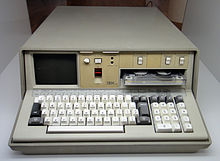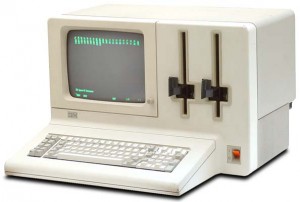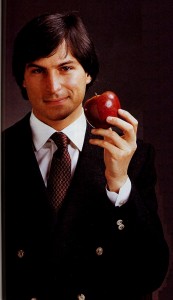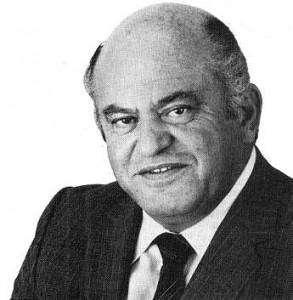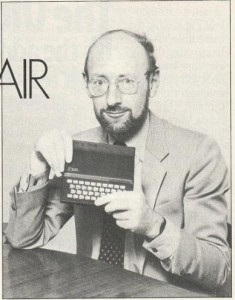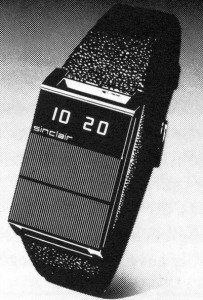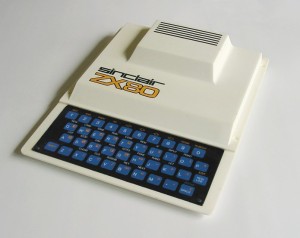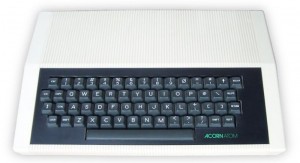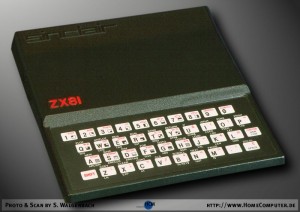Having been so favorably impressed with Bill Gates and Microsoft, Jack Sams returned to them almost as soon as IBM officially gave Project Chess the green light — on August 21, 1980. After having Gates sign yet another NDA, he was ready to move beyond the theoretical and talk turkey. He explained that IBM was planning to make its own PC, something that surprised no one in the room. In keeping with the philosophy of building a machine that could be configured to do anything, he planned to offer the user a choice of using a ROM-hosted BASIC environment similar to that of the Apple II, PET, and TRS-80, or of booting into the disk-oriented operating system CP/M, hugely popular among business users. Microsoft, the premier provider of microcomputer BASICs, was the obvious place to go for the first of these. They had also recently branched out into other, compiled languages like FORTRAN, and Sams wouldn’t mind having him some of those either. Robert X. Cringely and others make much of IBM’s turning to an outside vendor like Microsoft for its software (more of the “slapdash” trope), but this was really not at all unusual. Apple, Commodore, and Radio Shack amongst many others had in fact all done the same, sourcing their BASICs from Microsoft.
Sams was, however, very confused about something else. That spring Microsoft had introduced its first hardware product, the Z80 SoftCard. It was a Z80 CPU on a card which plugged into one of the Apple II’s expansion slots. Once the card was installed, the user could elect whether to give control of her machine to its standard 6502 CPU or to the Z80; the card contained circuitry to allow the Z80 to use the Apple II’s standard memory and other peripherals. Developed in partnership with Seattle Computer Products, a small hardware company with which Microsoft had quite close relations at this time, it really was a marvelous little hack. Because CP/M ran only on Z80 processors, Apple II users had hitherto been cut off from the universe of CP/M business software. Now they had the best of both worlds: all of the fun and educational software that took advantage of the Apple II’s graphics capabilities (not to mention VisiCalc), and all of the text-oriented, businesslike CP/M applications. The SoftCard became a huge success, second only to VisiCalc itself in making the Apple II the only 6502-based machine to be significantly adopted by American business; an Apple II with SoftCard soon became the single most popular CP/M hardware configuration. Based on the SoftCard, which shipped with a copy of CP/M, Sams assumed that Microsoft owned the operating system. Now Gates explained that this was not the case, that Microsoft had only licensed it from its real owner, a company called Digital Research.
Gates and Gary Kildall, the head of Digital and original programmer of CP/M, had known each other for years, and had developed a mutual respect and sort of partnership. When a new machine came out, Microsoft did the languages and Digital did the operating system. Steve Wood, an early Microsoft programmer:
“When we were talking to another OEM, a hardware customer who wanted to run BASIC or any of our products, we got to a point by 1977 or ’78 where we were always trying to get them to go to Digital first and get CP/M running because it made our job a whole lot easier. When we were doing custom things like the General Electric version or NCR version, it got to be a real headache. It made our lives a lot easier if someone would just go license CP/M and get that up on their machines and then our stuff would pretty much run as is. And Gary would do likewise. If someone went to him to license CP/M and they were looking for languages, he would refer people to Microsoft. It was a very synergistic kind of thing.”
Gates and Kildall had even discussed merging their companies at one point. As it was, there was a sort of unwritten understanding that Microsoft would stay out of operating systems and Digital would stay out of languages. In late 1979, however, Digital began distributing a non-Microsoft BASIC with some of their CP/M packages, a development Gates and others at Microsoft viewed as a betrayal of that trust.
Still, Gates dutifully called Kildall right there in Sams’s presence to set up a meeting for Sams and his team for the very next day. He told him they were very important customers, “so treat them right.” For his part, Sams was not thrilled. He was so very impressed with Gates and Microsoft, and “we really only wanted to deal with one person” for all of the systems software. Yet he didn’t see a choice. CP/M, you’ll remember, ran on the Z80 CPU. Sams therefore needed much more than to just purchase a license from Digital; he needed them to agree to port the operating system to the newer 8088 architecture, and to do it on his schedule. The next morning he and his team were on an airplane bound for Pacific Grove, California, home of Digital Research.
This is where the story gets famously unclear. Both Sams and Kildall were asked many times in later years about the events of August 22, 1980. Their stories are so factually disparate that it seems impossible to attribute their differences to mere shading or interpretation. Someone (or perhaps both), it seems, was simply not telling the truth.
Sams claims that he and his team arrived at the Victorian house that served as Digital’s headquarters right on time, only to be told that Kildall had decided to take advantage of a beautiful day by blowing off the meeting and going flying in his private plane. Sams and company were left in the hands of Digital’s business manager, Kildall’s wife Dorothy. Shocked but stalwart, Sams pulled out his NDA as a prelude to getting down to business. Now, on the face of it, this was an intimidating and unfair agreement, saying essentially that the other party could be sued if they revealed any of IBM’s secrets, but that IBM had complete immunity from legal action for the reverse. Gates had had, in his own words, “faith,” and signed right away. Dorothy, however, said no, that she would have to consult with her lawyer first. While Sams fidgeted impatiently in the lobby, she and the lawyer, Gerry Davis, dithered until three o’clock in the afternoon, when she finally signed. With most of the day gone and with the technical mastermind who would need to actually do the port not even present, negotiations didn’t really get anywhere. Sams left Digital, frustrated and annoyed, without even the beginning of an agreement, and immediately started casting about for an alternative to dealing with these people.
For his part, Kildall (who died in 1994 under very strange circumstances) admitted that he was out flying when Sams arrived for his meeting. He claimed, however, that, far from joyriding (joyflying?), he was flying himself home from a business trip. He said it was perfectly okay for the IBM team to have been left in the hands of Dorothy at the beginning of the meeting, as she was much more involved in all business negotiations than he. He nevertheless said that he was back by the afternoon, and that it was in fact him who convinced Dorothy and Davis to just sign the NDA and get on with it. After that negotiations proceeded quickly, and IBM and Digital had a “handshake agreement” by the time the day was over. Further, Kildall claimed that he and Dorothy flew out that night (via commercial airliner this time) to begin a vacation in Florida, and that the IBM group happened to be on the same flight. There they all talked about their plans some more.
Sams says that he did not even fly to Florida immediately after the meeting, but rather back to Seattle to continue to talk with Microsoft, admitting only that perhaps one or two members of the group might have gone directly back to Boca Raton. For years he also adamantly maintained that he never met Kildall at all that day, “unless he was there pretending to be someone else.” Only in recent years has he softened that stance somewhat, saying it’s “possible” Kildall was there, although he “doesn’t remember it.” He also recently said, “We spun it, Kildall spun it, and Microsoft spun it.” This might be read as the last refuge of a man who hasn’t always been entirely truthful, but who knows really. There are witnesses that partially corroborate each version of events. A Digital executive and friend of Kildall named Tom Rolander says he was on the business trip with Kildall, and that they did indeed meet with Sams that afternoon. Meanwhile Davis, Digital’s lawyer, says that he is certain no handshake deal was reached that day, and other IBM staffers do recall Sams saying immediately after the expedition that Kildall never showed up for the meeting.
So, what to make of all this? We might start by looking at Kildall’s personality in contrast to Gates’s. Popular accounts of these events often boil Gates and Kildall down to caricatures, the maniacally driven East Coast businessman versus the laid-back California hippie. They’re actually not awful as caricatures go. Both were wonderful hackers, but they could otherwise have hardly been more different. Gates was determined to prove himself and to win, over and over. When a bigger fish like IBM came calling, he was perfectly willing to humble himself, even to the point of obsequiousness, as long as he needed them as a steppingstone to the next level. (Once he didn’t need them anymore, of course, all bets were off.) It may not have been grounded in the most admirable of traits, but Gates’s ambition made Microsoft beloved by many of their partners. Not only had Gates assembled a very talented team, but they reflected their boss’s personality in being willing to work like dogs and walk through walls to get the job done and outdo their competitors. Kildall, meanwhile, often didn’t even seem certain he wanted to be running a business in the first place:
In one of the darkest of those moments in the late ’70s, Gary passed the parking lot by on his way in to work, and continued around the block, realizing that he just couldn’t bring himself to go in the door. He circled the block three times before he could force himself to confront another day at DRI.
One can’t imagine a remotely similar moment of doubt plaguing Gates.
The joy of hacking was what was important to Kildall. Users needed just be patient. While he would be happy to work with IBM, they needed to get in line like everyone else. Certainly he wasn’t interested in groveling to them. Digital’s vice president in 1980, Gordon Eubanks, says, “Gary cared a lot more about partying than running a business.” In addition to partying, Kildall cared about software. Gates cared about the software business. Eubanks:
The differences between Bill and Gary were just striking. Bill saw an opportunity, he would drive, he’d commit, he’d probably over commit, no problem. Gary was like, “I don’t care, I’m Digital Research. You deal with me, and you deal with me on my terms.”
And then of course there’s the personality of Sams, or rather of his corporate parent. IBM was the big dog in computers, and they expected to be treated like it. If they condescended to visit the likes of Microsoft or Digital, they should be treated like the VIPs they were, shown that the company in question really wanted their business. When Digital failed to demonstrate their respect and thankfulness to the same degree as did Microsoft — and whatever else happened that day, it does seem pretty clear that this at least was the case; Eubanks describes Dorothy as constantly “bitchy” to everyone, including potential customers — Sams was angry. “Don’t these people know who I am?” he must have wondered. Further, it’s pretty clear that Sams was unhappy about having to deal with Digital in lieu of Gates before he ever boarded that flight for California. As our mothers always told us, going into something with a bad attitude usually yields a bad result.
What is certain is that, handshake or no handshake and regardless of what impression Kildall might have been under, Sams was not pleased with his experience at Digital. He asked Gates, who had by this time signed an official consulting deal, whether he might find him an alternative to CP/M. Gates said he would see what he could do. In the meantime Sams claims he continued to try to work out something with Digital, but couldn’t get a commitment to develop an 8088 CP/M on the strict timetable he needed. Eubanks says that Kildall just didn’t find the project all that “interesting,” in spite of the obvious, pressing business need for it, and thus worked on it only halfheartedly.
And then Gates came back with QDOS.
